Whether you’re working with a tight budget or not, understanding the cost of baseball stadium lights is crucial for effective planning. The price of lighting for a baseball or softball field depends on several factors, including the size of the infield and outfield, specific lighting requirements, the layout of light poles, and other considerations. This article explores the key factors influencing the cost, provides an overview of average lighting expenses, and offers tips on finding affordable lighting solutions.
For a quick overview: baseball field LED lighting typically costs between $12,480 and $117,000. Additionally, the running cost for baseball or softball field floodlights generally ranges from $6 to $60 per 10,000 watts per hour. Selecting the appropriate type of lighting can lead to significant savings on electricity costs over time.
Table of Contents
ToggleSoftball Stadium and Baseball Field Light Cost Calculation
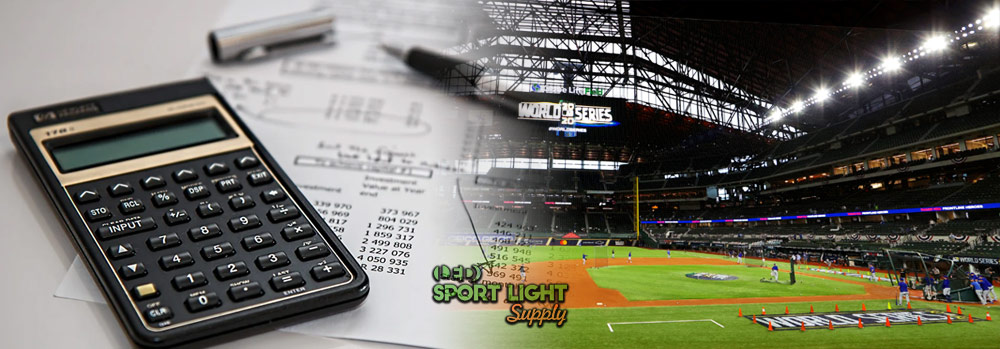
How to Calculate Baseball Field Lighting Cost
To estimate the cost of baseball field lighting, you’ll need to follow a systematic approach. First, calculate the lumen requirement for the field using the following formula:
Lumen Required = Lux Required × Field Area (in sq. meters) × 1.2 (Light Loss Factor)
Next, convert the lumen requirement into the wattage needed for the lighting fixtures:
Wattage of LED Lights = Lumen Required / 150 (Lumens per Watt)
Finally, determine the total cost of the baseball stadium lights by applying the cost range per watt:
Baseball Lighting Price = Wattage of LED Lights × ($0.6 to $1.5 per Watt)
Assuming a baseball field area of 6,500 sq. meters, here’s how the costs break down for different types of fields:
Lighting Cost for Different Types of Baseball Fields
Recreational Baseball Field (400 Lux)
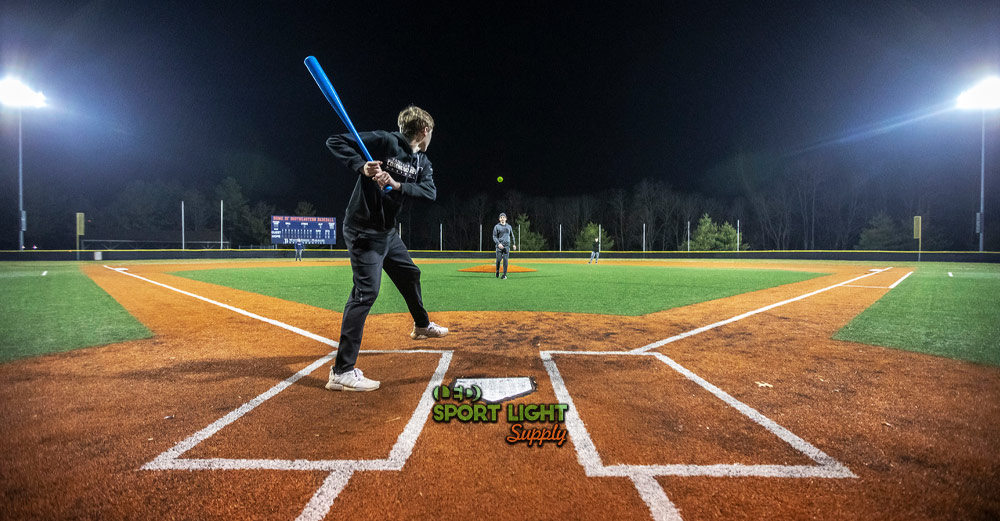
For a recreational baseball field that requires 400 lux:
- Lumen Required = 400 lux × 6,500 sq. meters × 1.2 = 3,120,000 lumens
- LED Wattage Needed = 3,120,000 lumens / 150 lumens per watt = 20,800 watts
- Lamp Cost = 20,800 watts × $0.6 to $1.5 = $12,480 to $31,200
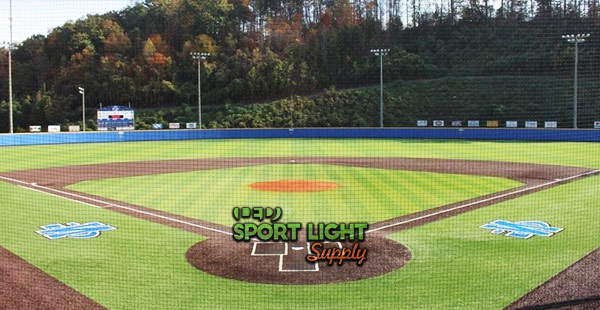
High School/College Baseball Field (700 Lux)
For a high school or college baseball field requiring 700 lux:
- Lumen Required = 700 lux × 6,500 sq. meters × 1.2 = 5,460,000 lumens
- LED Wattage Needed = 5,460,000 lumens / 150 lumens per watt = 36,400 watts
- Lighting Cost = 36,400 watts × $0.6 to $1.5 = $21,800 to $54,600
Professional/MLB Baseball Diamond (1500 Lux)
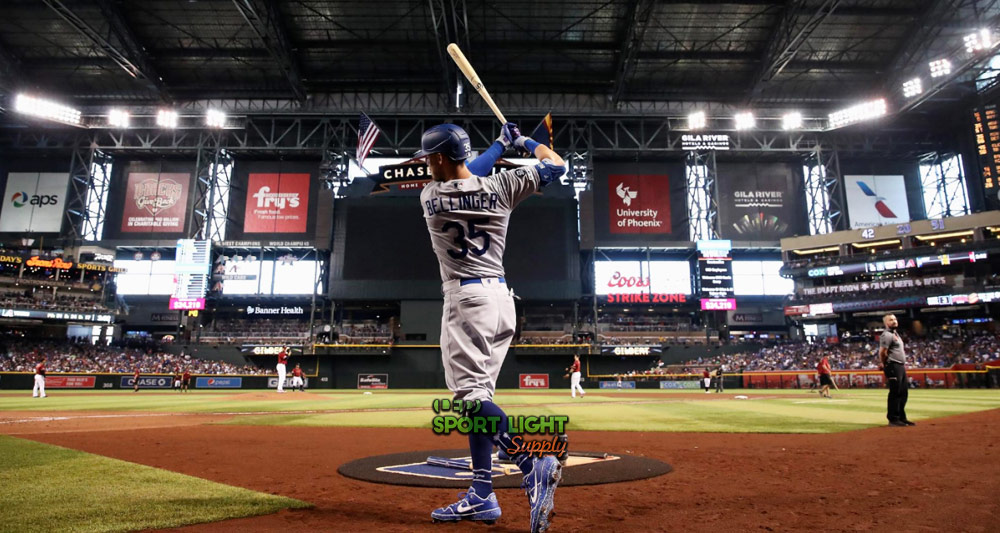
For a professional or MLB baseball diamond that needs 1500 lux:
- Lumen Required = 1500 lux × 6,500 sq. meters × 1.2 = 11,700,000 lumens
- LED Lighting Wattage Needed = 11,700,000 lumens / 150 lumens per watt = 78,000 watts
- Lighting Cost = 78,000 watts × $0.6 to $1.5 = $46,800 to $117,000
Baseball/Softball Stadium Lights Running Cost
How to Calculate Baseball Field Running Cost
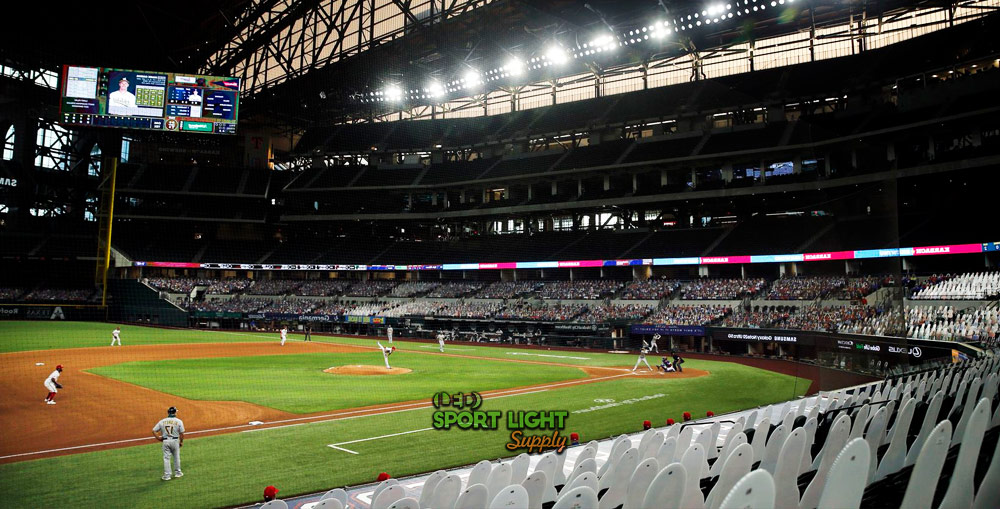
Understanding the running cost of stadium lights is crucial for effective budgeting and long-term savings. Here’s how you can calculate the running cost for baseball field lighting.
LED Lighting Cost Calculation
For instance, if you use 10,000 watts of LED lights and operate them for 6 hours per day:
- Daily Cost = 10,000W × 6 hours × $0.1 / 1,000 = $6 per day
- Monthly Cost = $6 per day × 30 days = $180 per month
- Annual Cost = $6 per day × 365 days = $2,160 per year
Halogen Lighting Cost Calculation
To produce the same brightness as 10,000 watts of LED lights, you would need 100,000 watts of halogen lights:
- Daily Cost = 100,000W × 6 hours × $0.1 / 1,000 = $60 per day
- Monthly Cost = $60 per day × 30 days = $1,800 per month
- Annual Cost = $60 per day × 365 days = $21,600 per year
As illustrated, the running cost for halogen lights is significantly higher—about ten times more—compared to LED lights. Therefore, switching to LED lights not only provides equivalent brightness but also offers substantial savings on electricity costs. For instance, 10,000 watts of LED lighting is comparable in brightness to 100,000 watts of halogen lights and 30,000 to 40,000 watts of metal halide lights.
Factors Affecting Baseball/Softball Field Lighting Cost
Level of Competition
The cost of lighting varies significantly based on the level of competition. Different levels, such as recreational, regional, national, and international tournaments, have distinct lighting requirements. Professional fields need brighter lights, leading to higher costs.
| Level of competition | Infield lux requirement | Outfield lux requirement |
| Recreational | 400 lux | 200 lux |
| High school / College / Training | 700 to 1000 lux | 350 to 500 lux |
| Professional (MLB) | 1500 lux | 1000 lux |
The increased lux levels required for higher competition levels result in a proportional increase in lighting costs. For example, a high school field requiring double the lux of a recreational field will generally cost twice as much to illuminate.
Baseball Field Size
The size of the baseball field directly impacts the cost of lighting. Larger fields require more lumens, which means more wattage and higher costs. Here’s a summary of common field sizes and their corresponding areas:
| Baseball field radius | Area |
| 46 m (150 ft) | 6,500 sq. m (70,000 sq. ft) |
| 53 m (175 ft) | 8,820 sq. m (95,000 sq. ft) |
| 61 m (200 ft) | 11,700 sq. m (126,000 sq. ft) |
| 69 m (225 ft) | 15,000 sq. m (161,000 sq. ft) |
| 76 m (250 ft) | 18,100 sq. m (195,000 sq. ft) |
| 84 m (275 ft) | 22,200 sq. m (239,000 sq. ft) |
| 91 m (300 ft) | 26,000 sq. m (280,000 sq. ft) |
Larger fields require proportionally more lighting, which increases both initial and ongoing costs.
Light Source
Different types of lighting—LED, halogen, metal halide, and mercury vapor—vary in cost and efficiency. While LEDs might have a higher upfront cost compared to HID lights, they offer superior luminous efficacy. For example, a 100W LED lamp can produce the same brightness as approximately 1,000 halogen lamps due to its higher lumens per watt.
To compare costs more accurately, consider the price per 100 lumens. For instance, if 150,000 lumens of LED lighting costs $8,000, this equates to $5.30 per 100 lumens.
Height of Light Pole
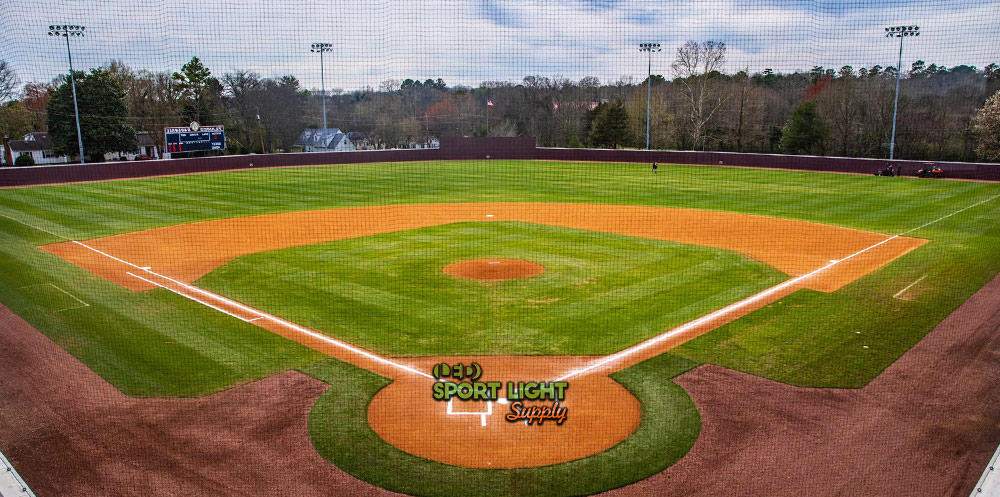
The height of the light poles impacts the cost as well. Taller poles increase light loss due to light spreading over a larger area, requiring more fixtures. Additionally, higher poles necessitate more investment in lightning protection systems. Typical pole heights are:
| Type of baseball field | Common light pole height |
| Recreational / Training | 12 to 15 m (39 to 49 ft) |
| High school / college | 15 to 20 m (49 to 65 ft) |
| Professional baseball stadium | 25 to 60 meters (82 to 196 ft) |
Light Pole Layout
The configuration of light poles—such as 4-pole, 6-pole, or 8-pole setups—affects both the cost and lighting quality. An 8-pole layout generally reduces light loss and glare, leading to a lower total lighting cost. However, the initial cost of poles and installation is higher. A 4-pole or 6-pole layout might save on pole costs but could increase glare and require more precise beam angles.
Solar Panels
Incorporating solar panels can reduce operating costs by 5% to 15% by harnessing solar energy. However, this depends on adequate sunlight exposure on the stadium roof. Solar panels can offset some of the electricity costs, though they typically cannot replace the entire lighting system.
Lamp Origin
The cost of lights varies by region. Lighting fixtures from Western countries like the US, UK, or Australia are often more expensive due to higher labor and manufacturing costs. On the other hand, sourcing lights from countries like India or China can be more cost-effective. However, caution is needed with very low-priced options, as they may be of lower quality and shorter lifespan.
CRI Required
High Color Rendering Index (CRI) lighting enhances the visibility of colors and can make the field look more professional. Higher CRI lighting typically requires more fixtures to achieve the same lumen output. For instance, a CRI over 85 may result in a higher cost due to increased fixture count and adjusted lumen output.
Lighting Uniformity Required
Achieving high lighting uniformity may necessitate additional fixtures to eliminate bright and dark spots. Uniformity ratios such as minimum-to-average or minimum-to-maximum illuminance ratios affect cost. For example, improving uniformity from 0.6 to 0.8 can increase lighting costs by 5% to 10%.
Special Lighting Control System
A sophisticated lighting control system can manage numerous LED floodlights efficiently. Advanced systems with DMX or DALI controls, and scheduling software, offer greater convenience but come at a higher cost. These systems can automate lighting for various events, saving time and enhancing operational efficiency.
How to Reduce Baseball Field Lighting Costs
Reducing the cost of baseball field lighting while maintaining the required standards involves strategic planning and smart choices. Here are several effective ways to save up to 5% to 20% on lighting expenses:
Optimize Lighting Design and Layout
A well-designed lighting layout can significantly reduce costs by minimizing the number of fixtures needed. Effective use of lighting design software like DIALux can help find the optimal arrangement of lights to achieve desired illuminance and uniformity with less power. This approach ensures that you use the least amount of lighting power necessary to meet the required standards, thus lowering both equipment and operating costs.
Invest in LED Lights
While the initial cost of LED lights is higher compared to traditional HID sources, their energy efficiency and long lifespan make them a cost-effective choice in the long run. LEDs consume less power and have a lifespan of up to 150,000 hours, reducing both energy bills and maintenance costs. Transitioning from metal halide, high-pressure sodium, or mercury vapor lights to LEDs can lead to significant savings over time.
Negotiate Bulk Purchase Discounts
Purchasing lights in bulk can lead to substantial savings. Suppliers often offer discounts for large orders, so it’s worthwhile to negotiate for better pricing when buying more than 50 fixtures. Additionally, informing suppliers of potential future orders can sometimes lead to even deeper discounts. Bulk buying can significantly lower the per-unit cost of lighting fixtures.
Consider Used Lights
Buying second-hand baseball field lights can offer significant savings, with prices often 30% to 50% lower than new fixtures. This option is particularly useful if your budget is tight. However, it’s important to assess the condition and compatibility of used lights with your field’s specifications. Be cautious about the remaining lifespan and warranty of used fixtures, as these factors can affect their overall value.
Compare Prices from Different Suppliers
Take the time to compare lighting prices from various suppliers and regions. Prices can vary widely depending on location and market conditions. By obtaining quotes from multiple sources, you can find competitive pricing and avoid overpaying. Comparing international and local suppliers can also uncover opportunities for savings, but ensure the quality of the lights meets your standards.
Increase the Number of Light Poles
Using more light poles can reduce the total lumens required per fixture, as each pole will cover a smaller area, leading to lower light loss. An 8-pole configuration, for example, can enhance lighting uniformity and reduce glare, although it may increase installation costs. More poles can also accommodate wider beam angles, improving overall lighting quality.
Opt for Shorter Poles
Shorter poles can reduce light loss and lower the total lumens needed, potentially cutting lighting costs by 5% to 10%. Lower poles reduce the distance light travels, thereby reducing the amount of light needed. However, this may affect lighting uniformity and create shadowed areas on the field. A height of 20 to 30 meters is typically effective for balancing cost and performance.
How to Select the Best Affordable Baseball or Softball Field Lighting Fixtures
Finding the best budget-friendly lighting fixtures for baseball or softball fields involves careful consideration of several key factors. Here’s a guide to help you make an informed choice:
Luminous Efficacy
LED lights typically offer a range of 130 to 200 lumens per watt. While higher efficacy, such as 200 lumens per watt, indicates greater energy efficiency, it can also be more costly. For a more cost-effective solution, it is advisable to look for LED lights with an efficacy between 130 and 170 lumens per watt. In contrast, metal halide lights provide approximately 65 to 80 lumens per watt, while halogen lights offer a much lower output, around 10 to 20 lumens per watt.
Beam Angle
The beam angle of a light fixture plays a crucial role in determining how light is distributed across a field. Choosing the appropriate beam angle can significantly impact the number of fixtures required for optimal illumination.
For high poles, which are typically over 30 meters in height, narrow beam angles between 15° and 25° are most efficient. These angles focus the light more directly, reducing light loss and ensuring that the light reaches the intended areas with minimal dispersion. In contrast, for shorter poles, wider beam angles such as 45°, 60°, or 90° are more effective. These wider angles allow the light to cover larger areas with fewer fixtures, making them suitable for fields with lower pole heights. By optimizing the beam angle according to the height of the poles, you can achieve effective illumination while also managing costs efficiently.
Lifespan
The lifespan of lighting fixtures is a critical factor in achieving long-term cost savings. Longer-lasting lights help reduce the frequency of replacements and the associated maintenance costs.
LED lights typically have a lifespan ranging from 80,000 to 150,000 hours. However, less expensive LED options might have a shorter lifespan of around 50,000 hours. In contrast, traditional lights generally have shorter lifespans compared to LEDs.
Choosing LED lights with a longer lifespan can help minimize the need for frequent replacements and reduce ongoing maintenance expenses, making them a more cost-effective option in the long run.
Heat Dissipation
Effective heat dissipation is crucial for maintaining the performance and extending the lifespan of lighting fixtures. There are two main types of cooling mechanisms to consider:
Passive Cooling utilizes materials such as aluminum to conduct heat away from the light source. This method is efficient as it does not consume additional power and relies on the natural heat conduction properties of the materials used.
Active Cooling involves the use of fans to lower the temperature of the light fixture. While this approach is more effective in managing heat, it requires extra power and can potentially affect the fixture’s IP rating if not properly designed to remain waterproof.
Portable Field Lights for Temporary Use
For fields that require infrequent use or temporary lighting, portable field lights are a practical choice. Mobile light towers are a notable option in this category. These towers typically include floodlights, a retractable pole, a generator, and a movable base, offering a flexible and cost-effective solution without the need for permanent installation.
Additionally, considering rental options for mobile light towers can further reduce costs, particularly if lighting is needed only occasionally. Portable lighting solutions like these are ideal for occasional use, as they help save on both installation and infrastructure expenses.
By evaluating these factors, you can select affordable lighting fixtures that meet the specific needs of your baseball or softball field without compromising on quality or performance.
Conclusion
Selecting affordable baseball or softball field lighting fixtures requires careful consideration of factors such as luminous efficacy, beam angle, lifespan, heat dissipation, and the option for portable lights. By opting for energy-efficient LEDs with a balanced efficacy, choosing the appropriate beam angle for your pole height, and prioritizing fixtures with effective heat dissipation and longevity, you can achieve cost savings both upfront and in the long run. Additionally, exploring portable lighting solutions for temporary needs can further reduce costs. By evaluating these factors, you can ensure that your lighting choice is both economical and effective, meeting the needs of your field while staying within budget.
